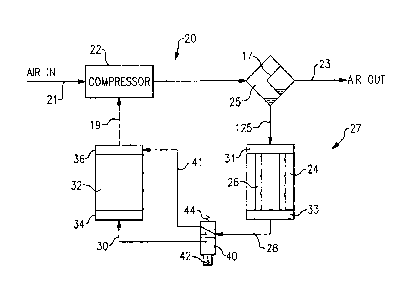Some of the information on this Web page has been provided by external sources. The Government of Canada is not responsible for the accuracy, reliability or currency of the information supplied by external sources. Users wishing to rely upon this information should consult directly with the source of the information. Content provided by external sources is not subject to official languages, privacy and accessibility requirements.
Any discrepancies in the text and image of the Claims and Abstract are due to differing posting times. Text of the Claims and Abstract are posted:
| (12) Patent: | (11) CA 2691461 |
|---|---|
| (54) English Title: | TWO-STAGE HEAT EXCHANGER WITH INTERSTAGE BYPASS |
| (54) French Title: | ECHANGEUR DE CHALEUR BI-ETAGE AVEC CONDUITE DE DERIVATION ENTRE ETAGES |
| Status: | Expired and beyond the Period of Reversal |
| (51) International Patent Classification (IPC): |
|
|---|---|
| (72) Inventors : |
|
| (73) Owners : |
|
| (71) Applicants : |
|
| (74) Agent: | NORTON ROSE FULBRIGHT CANADA LLP/S.E.N.C.R.L., S.R.L. |
| (74) Associate agent: | |
| (45) Issued: | 2014-09-16 |
| (22) Filed Date: | 2010-02-01 |
| (41) Open to Public Inspection: | 2010-08-13 |
| Examination requested: | 2010-02-01 |
| Availability of licence: | N/A |
| Dedicated to the Public: | N/A |
| (25) Language of filing: | English |
| Patent Cooperation Treaty (PCT): | No |
|---|
| (30) Application Priority Data: | ||||||
|---|---|---|---|---|---|---|
|
A fluid cooler comprises a first stage fluid cooler and a downstream second stage fluid cooler. A flow line connects the first and second stages. A valve senses a condition of the fluid in the flow line, and to bypass the second stage fluid cooler if it is determined that additional cooling is not necessary. An air compressor incorporating the cooler is also claimed as is a method of operating a fluid cooler.
Refroidisseur de fluide comprenant un refroidisseur de fluide initial et un refroidisseur de fluide secondaire en aval. Une ligne d'écoulement relie les deux phases. Une vanne détecte la condition du fluide dans la ligne d'écoulement et entraîne le contournement du refroidisseur de fluide secondaire si une deuxième phase de refroidissement n'est pas nécessaire. L'invention concerne aussi un compresseur d'air dans lequel se trouve le refroidisseur, ainsi qu'une méthode d'exploitation d'un refroidisseur de fluide.
Note: Claims are shown in the official language in which they were submitted.
Note: Descriptions are shown in the official language in which they were submitted.

2024-08-01:As part of the Next Generation Patents (NGP) transition, the Canadian Patents Database (CPD) now contains a more detailed Event History, which replicates the Event Log of our new back-office solution.
Please note that "Inactive:" events refers to events no longer in use in our new back-office solution.
For a clearer understanding of the status of the application/patent presented on this page, the site Disclaimer , as well as the definitions for Patent , Event History , Maintenance Fee and Payment History should be consulted.
| Description | Date |
|---|---|
| Time Limit for Reversal Expired | 2017-02-01 |
| Letter Sent | 2016-02-01 |
| Grant by Issuance | 2014-09-16 |
| Inactive: Cover page published | 2014-09-15 |
| Inactive: Final fee received | 2014-06-27 |
| Pre-grant | 2014-06-27 |
| Notice of Allowance is Issued | 2014-05-14 |
| Letter Sent | 2014-05-14 |
| Notice of Allowance is Issued | 2014-05-14 |
| Inactive: QS passed | 2014-05-12 |
| Inactive: Approved for allowance (AFA) | 2014-05-12 |
| Amendment Received - Voluntary Amendment | 2014-01-31 |
| Inactive: S.30(2) Rules - Examiner requisition | 2013-08-01 |
| Amendment Received - Voluntary Amendment | 2013-01-22 |
| Inactive: S.30(2) Rules - Examiner requisition | 2012-07-26 |
| Amendment Received - Voluntary Amendment | 2012-03-22 |
| Inactive: S.30(2) Rules - Examiner requisition | 2011-09-26 |
| Application Published (Open to Public Inspection) | 2010-08-13 |
| Inactive: Cover page published | 2010-08-12 |
| Inactive: IPC assigned | 2010-07-19 |
| Inactive: First IPC assigned | 2010-07-19 |
| Inactive: IPC assigned | 2010-07-19 |
| Inactive: IPC assigned | 2010-03-12 |
| Inactive: Filing certificate - RFE (English) | 2010-02-26 |
| Filing Requirements Determined Compliant | 2010-02-26 |
| Letter Sent | 2010-02-26 |
| Application Received - Regular National | 2010-02-26 |
| Request for Examination Requirements Determined Compliant | 2010-02-01 |
| All Requirements for Examination Determined Compliant | 2010-02-01 |
There is no abandonment history.
The last payment was received on 2014-01-07
Note : If the full payment has not been received on or before the date indicated, a further fee may be required which may be one of the following
Please refer to the CIPO Patent Fees web page to see all current fee amounts.
| Fee Type | Anniversary Year | Due Date | Paid Date |
|---|---|---|---|
| Application fee - standard | 2010-02-01 | ||
| Request for examination - standard | 2010-02-01 | ||
| MF (application, 2nd anniv.) - standard | 02 | 2012-02-01 | 2012-01-05 |
| MF (application, 3rd anniv.) - standard | 03 | 2013-02-01 | 2013-01-09 |
| MF (application, 4th anniv.) - standard | 04 | 2014-02-03 | 2014-01-07 |
| Final fee - standard | 2014-06-27 | ||
| MF (patent, 5th anniv.) - standard | 2015-02-02 | 2015-01-07 |
Note: Records showing the ownership history in alphabetical order.
| Current Owners on Record |
|---|
| SULLAIR CORPORATION |
| Past Owners on Record |
|---|
| ANDREW MCDAVID |
| BRIAN M. TYLISZ |
| ROBERT A. COUNTISS |